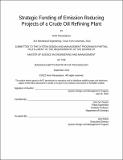Strategic Funding of Emission Reducing Projects of a Crude Oil Refining Plant
Author(s)
Ravassipour, Amir
DownloadThesis PDF (918.8Kb)
Advisor
Deutch, John M.
Terms of use
Metadata
Show full item recordAbstract
This thesis seeks to provide an economical method for strategic funding of emission-reducing projects of a crude oil refining plant. This economic model utilizes mathematical optimization of profits as the justification for funding projects. The optimization method finds justification for the minimization of operating cost and, more specifically, the minimization of emission cost as a method to maximize profits. The emission cost is measured as the summation of the carbon charge associated with the plant’s emission and the cost of funding emission-reducing projects. The strategy of the plant is to fund projects that contribute to emission abatement at a higher economic value than their respective costs of implementation.
The costs of potential projects are levelized by measuring each project’s total cost against its lifecycle emission abatement and introducing the levelized cost of carbon as the measure for comparing projects to one another. Projects with a lower levelized cost of carbon than the carbon charge will create economic value for the firm and will be funded.
The total emission abatement of the plant is determined through the relationship between the marginal cost of the emission-reducing projects and their cumulative emission abatement. The project with the levelized cost of carbon equal to the carbon charge will determine the threshold for all other projects that will be funded. This thesis bounds these projects at the lower end with no projects funded scenario and at the top end with negative emissions levelized cost of carbon.
The input of the discount rate, interest rate, and utility rate of the facility creates a sensitivity analysis of their respective impacts on the levelized cost of carbon. The future emissions discount rate impacts the lifecycle emission abatement of projects. Emission discount rate and lifecycle emission abatement of projects carry an inverse relationship. The plant can reduce its capital exposure by gaining access to cost-effective capital to fund its emission-reducing projects. The interest rate of these loans impacts the levelized cost of carbon. The utility rate of the facility and its future state will create a contrast in favoring capital-intensive vs. operating expense-intensive projects.
This optimization strategy has to be tailored to each plant’s set of projects as well as their respective added constraints. This thesis explores constraints such as budgetary cap and minimum emission abatement requirements to understand the change in strategy of the firm given these constraints.
The overall strategy of the firm will depend on three main components. First, to analyze emission-reducing projects; determine their cost and emission abatement; second, to forecast the cost of carbon. And third, to fund projects that create emission abatement and carbon charge savings greater than the cost of funding them.
Date issued
2022-09Department
System Design and Management Program.Publisher
Massachusetts Institute of Technology